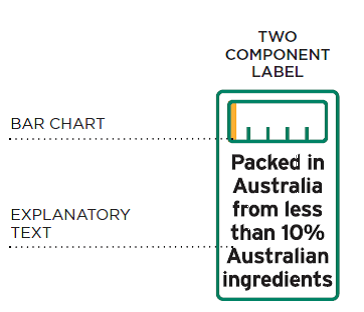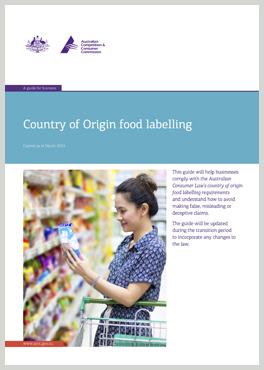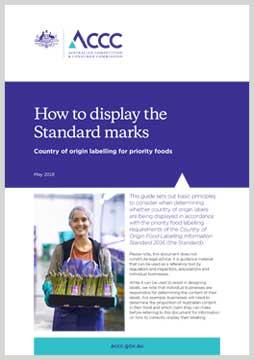When origin labelling on food is required
The Country of Origin Food Labelling Information Standard 2016 requires most foods that are offered for retail sale to have information on the country where the food was grown, produced or made.
Most packaged food must have a country of origin label if it's sold in a retail setting, such as a supermarket, local store or market, online or from a vending machine.
Country of origin information is also required for some unpackaged foods when sold in a retail setting. This includes:
- fruits
- vegetables
- nuts
- spices
- herbs
- fungi
- legumes
- seeds
- fish and most meat, or
- a mix of these foods.
This information should accompany the food, for example, on a sign next to the product in-store.
Country of origin labels are not required on food in certain circumstances. This includes food bought from:
- restaurants
- cafes
- take-away shops
- schools
- caterers.
Businesses may still choose to provide country of origin information in these circumstances. However, if a business wants to use the kangaroo logo or bar chart, the use of these graphics must follow the Food Labelling Standard.
Whether or not a business is required to follow the Food Labelling Standard, their country of origin claims about food must be true, accurate and based on reasonable grounds.
A business is unlikely to be making misleading claims if its country of origin labelling fully complies with the Food Labelling Standard.
If an allegation is made that a business has breached the Australian Consumer Law by making a country of origin claim, the business can rely on an automatic defence, known as a ‘safe harbour’, if it has complied with the Food Labelling Standard. However, if a package displays extra images or representations that create an overall misleading impression, the business may be at risk of breaching the Australian Consumer Law and penalties may apply.
Our Country of origin food labelling guide has further details on the types of food that require a country of origin label.
Types of labelling required on food
For foods that require country of origin labelling, the type of labelling that's required depends on:
- whether the food is grown, produced, made or packed in Australia or another country
- whether the food is considered non-priority or priority.
Businesses should understand the differences between ‘grown in’, ‘produced in’, ‘made in’ and ‘packed in’ claims when labelling products. See Country of origin claims for more information.
Non-priority and priority foods
Foods that require country of origin labelling have different labelling requirements depending on whether they are classified as priority or non-priority foods.
Foods that require country of origin labelling are considered priority foods, unless they fall in one of the non-priority food categories.
Non-priority food categories include:
- seasoning
- confectionery
- tea and coffee
- biscuits and snack food
- bottled water
- soft drinks and sports drinks
- alcohol.
These non-priority foods only require a text statement about where the food was grown, produced, made or packed.
Examples of foods that fall within the non-priority food category, and foods that are specifically excluded from the non-priority food category, are set out in the Food Labelling Standard.
All foods other than non-priority foods are considered priority foods. Priority foods include:
- fruit and vegetables
- meat
- seafood
- bread
- milk
- juice
- sauces
- honey
- nuts
- cereal.
Formats for labels
The Food Labelling Standard has 3 general formats for country of origin food labelling.
Three component standard mark
A graphic and text-based label which is mandatory for priority food items grown, produced or made in Australia.
The label includes:
- the kangaroo in a triangle symbol so consumers can identify the food is of Australian origin
- the minimum proportion, by ingoing weight, of Australian ingredients, shown in a shaded bar chart
- a statement identifying whether the food was grown, produced or made in Australia and in the case of 'made in' claims, the percentage of Australia ingredients in the food.
Two component standard mark
A graphic and text-based label which is mandatory for most priority food items packed in Australia. It may also be used for imported foods to show they contain Australian ingredients.
The label includes:
- the minimum proportion, by ingoing weight, of Australian ingredients, shown in a shaded bar chart
- a text statement with an origin claim for the food and identifying the percentage of Australian ingredients in the food.
If a priority food was packed in Australia but does not meet the requirements to be labelled as grown, produced or made in Australia, then it can't carry the kangaroo logo.
Country of origin statement
A text-only label is used for non-priority food items.
Imported priority foods must also carry a country of origin statement in a clearly defined box (a box is not required if the food is unpackaged).
Compliance and enforcement approach
The ACCC and other Australian Consumer Law regulators have the power to call on businesses to substantiate the country of origin claims made on their labels.
Where we identify possible non-compliance with the Food Labelling Standard, we'll take the surrounding circumstances into account. For example, we generally distinguish between:
- genuine efforts by a business to comply, and
- a business that deliberately breaches the requirements in the Food Labelling Standard or makes false or misleading origin claims.
Businesses should also take reasonable steps to correct any country of origin claims that become incorrect due to manufacturing or supply chain changes.
We're unlikely to take enforcement action where a business has attempted to follow the requirements, is responsive to our concerns and agrees to timely remediation.
We look to resolve many matters by communicating with businesses to seek changes to address non-compliance. Where stronger action is needed, we escalate matters and take an enforcement approach. This is done in line with principles set out in our Compliance and enforcement policy.
We're more likely to take enforcement action where:
- businesses fail to respond to our concerns or choose not to take steps to mitigate compliance failures, or
- the issues go beyond a failure to follow labelling requirements and involve claims or labelling that is likely to mislead consumers.
We're also more likely to take action where this behaviour is by large or national traders and impacts many consumers.









